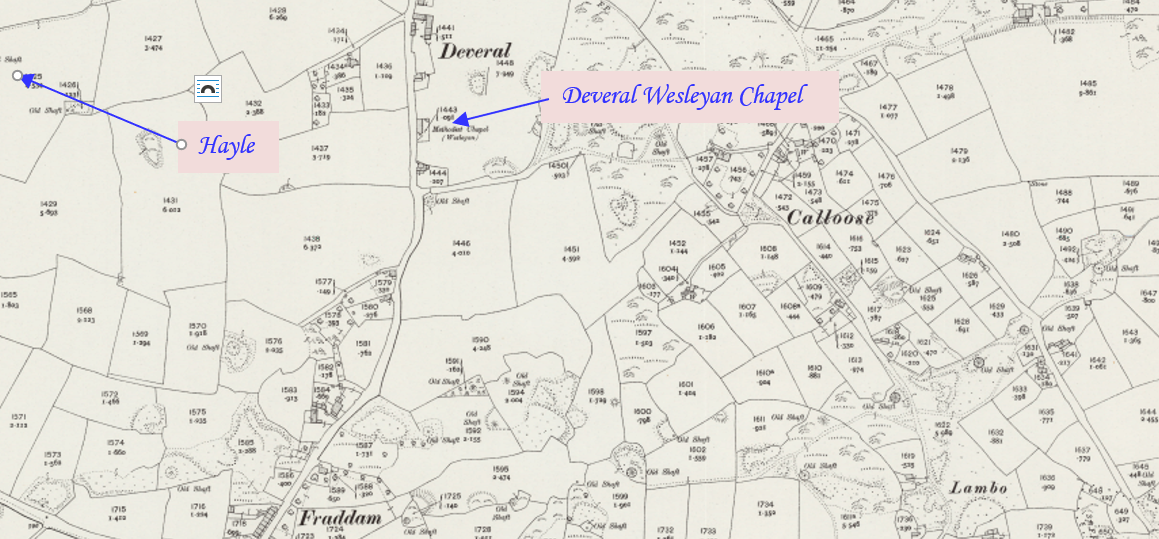
Deveral is a hamlet in the parish of Gwinear-Gwithian (1908 OS 1:2,500 map extract). This profile of Deveral Wesleyan Chapel has been compiled by Guy Channer.
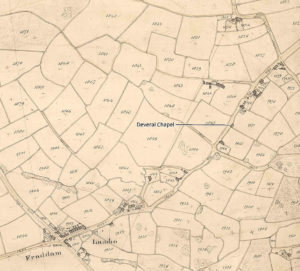 1840 Tithe Map extract indicating a building on the site of Deveral Chapel
1840 Tithe Map extract indicating a building on the site of Deveral Chapel
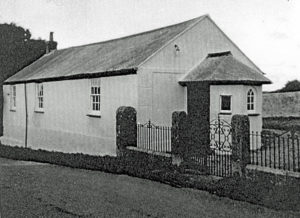 Deveral Chapel in 1966 shortly after last external redecoration as a working chapel (Photo: Cedric Appleby)
Deveral Chapel in 1966 shortly after last external redecoration as a working chapel (Photo: Cedric Appleby)
 Deveral Chapel in disrepair in 1986 at time of Grade II listing designation (Photo: Eric Berry)
Deveral Chapel in disrepair in 1986 at time of Grade II listing designation (Photo: Eric Berry)
 Deveral Chapel in 2015 now converted to residential use (Photo: Guy Channer)
Deveral Chapel in 2015 now converted to residential use (Photo: Guy Channer)
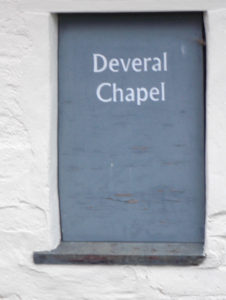 This name plaque has been fastened to what was once a Porch window, itself a 1963 alteration to the original early 19thC porch. (Photo: Paul Phillips)
This name plaque has been fastened to what was once a Porch window, itself a 1963 alteration to the original early 19thC porch. (Photo: Paul Phillips)
History
Deveral Chapel is situated between the small hamlet of Deveral and village of Fraddam in what is today a primarily agricultural landscape. It consists of a 10.5m x 5.0m rectangular hall on a north-south axis, entered via an octagonal porch on its southern end, with a smaller vestry space to the north. The building lies on the east side of Deveral Road within a stone walled enclosure with gates and railings on its south west corner. A shed with a large fireplace and chimney and a brick-built, outside privy are situated on the north west corner of the plot.
The chapel reputedly opened circa 1793-4 (Stell). The surrounding area was the scene of significant copper and tin mining activity in the late 18th and 19th centuries. The nearest mine, Calloose, lay just two fields away and old shafts and mining spoil heaps are visible from the chapel. Its peak output of copper ore was in the late 18th C, so the chapel may therefore have been established at a time of growing population and served both the pre-existing farming and growing mining communities.
An estate survey map of the Duke of Leeds Manor of Trenerth lands dating from 1788 indicates the area of land on which the chapel lies as being owned by ‘Mrs Hearle’. (The major Herland Mine workings, which take the Hearle family name, were situated just 1 mile to the north of the chapel.) Deveral is also included in a schedule of Hearle lands under the Manor of Trelissick dated 1800.
A building is shown on the site of the chapel in the 1840 Tithe map situated at a field entrance on the boundary between two fields on lands owned by John Hearle Tremayne. Although it is not labelled, the adjacent field is named as ‘chapple field’ in the Tithe apportionments. The 1879 Ordnance Survey 1:2,500 scale map specifically identifies the chapel as being Wesleyan and clearly shows its porch feature. The 1908 sheet indicates development of an enclosed plot with the vestry and outbuildings also indicated. Trustee minutes and accounts indicate a date of construction of the boundary wall of 1895-1897. These also show that freehold of the chapel was purchased from the Tremayne family in 1903.
The chapel ceased operation in 1975 with a final service held on May 11. It was then sold, initially to a Mr and Mrs Hicks and eventually passed to a local farming family the Eustice’s, who used it as a rough store until 2004, when it was then sold with planning consent for conversion to its current, residential use.
The original rectangular building had lime-rendered, 2ft thick cob walls, with its southern, gable end of rough stone and a simple pitched roof over A-frame trusses with wet-laid scantle slate and cast-iron, ogee gutters. There are pair of six-over-six, hornless sash windows on the east and west elevations and an entrance door in the centre of the southern elevation . The hall’s north wall (ritual east) has a flat-arched reveal housing the leader’s pew below a finely painted original mural in gold script ‘Enter His Gates with Praise’.
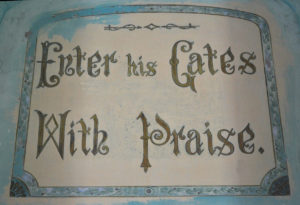 The gold lettered mural above the leader’s pew (Photo: Guy Channer)
The gold lettered mural above the leader’s pew (Photo: Guy Channer)
During renovation work in 2005-6 evidence was uncovered of both an earlier entrance door on the south west wall of the hall and a larger opening, or possibly matching reveal, in the southern wall. The exterior of the southern elevation has decorative lime render finish with quoins and scored lines mimicking ashlar stone coursework.
The brick built porch has a small gothic arched window on its southern facet and a bi-folding panelled entrance door on its west face with glazed overlight. The hipped roof was also wet-laid scantle slate covered with black-glazed ridge tiles. During repair works shards of red and blue original glass were found in the otherwise bare window frame, which informed the use of colour in the renovated window. An additional rectangular window was cut into the south west brick facet between the door and the original window in 1963. The porch was evidently added onto an already decoratively rendered south wall of the chapel as the ‘ashlar’ plaster work detailing of the chapel runs through the junction of the two. The age of the porch has been estimated to be early 19thC (refer 2005 assessment below)
The vestry and Sunday School Room is constructed of rubble stone and 3m x 5m in area with a pitched roof matching into the line of the ridge of the main hall and 2ft thick walls to tie into the original chapel. Trustees minutes and accounts indicate a date of construction of 1885-1887. The room has a 12 pane sash in its west wall, panelled entrance door with glazed overlight in east wall and doorway opening into the hall on its west side. The original purpose of a large bricked up window opening on north wall at low level is unclear. At the time of conversion it had latterly been used as a shallow book-case style cupboard with shelves and a possibly glazed door, themselves of some age. The remains of a window frame were discovered behind the cupboard lining during conversion. A small granite-lined fireplace was also discovered behind brick and plaster covering on the north wall which connects to the external brick chimney stack.
Interiors:
The hall has a raised timber floor over earth with stepped terraces to the southern end and gated box pews with faux woodgrain effect. Only three rows of pews remained by 2004 and these were in very poor condition. During conversion two rows were restored from these and reinstated. The largely surviving timber floor planks are of different types and ages, with those at the north end of larger and varying widths (8-15 inch) and lengths supported above a shallow void on rough sawn timbers, whereas the main part of the hall has consistent sizes of 6”dowelled boards supported above a 2ft void with stone dwarf walls at third points of the rectangular joints. The pew terraces have wider boards (up to 15 inch), but of similar thickness and timber. Two section of cast-iron piping running below the seats of the remaining pews are consistent with mentions in trust minutes and accounts of a coal or coke fired heating boiler, possibly located in front of the blocked-in fireplace in the vestry (see below).
During renovation and conversion remnants of an original lime-ash floor were discovered below the pew terraces. This had evidently been excavated to allow the later construction of a floor void and a tightly dowelled floorboard timber structure through the central half of the hall. The patina of these central floor boards indicates that four rows of fixed pews extended through the flat floor area towards the front (north) of the chapel and the position of the semi-circular choir rail is also still evident. Remnants of the steps up to the leader’s rostrum and pew were discovered during the conversion works, but no other fixtures remained except, mostly snapped off, wall-mounted peg rails. The distinctive pegs have been identified as being of a design attributed to the architect CFA Voysey and probably therefore late 19thC. There had evidently been timber panelling to dado height along the internal walls of the hall, however none of this remained at the time of conversion. During renovation works remains of two wooden pulleys were discovered above the secondary 1950s woodwool ceiling, which would have been used to raise and lower oil lamps for lighting before an electrical supply existed.
The vestry’s floor level was approximately a foot lower than that in the main hall with a step or ramp between. There had been a raised timber floor over ventilated void here too, however this was removed in 1965 when dry rot was discovered, backfilled with sand and stone and a rough concrete slab cast over. During renovation works in 2007 this slab and infill material was removed to reveal the original sub-floor void and dwarf walls supporting N-S spanning floor joists. During the works a covered-over granite-lined fireplace was also opened up which connected to the chimney stack on the north gable wall. A mains water connection entered the floor void directly from the lane, but was not recorded on the utility network plans. There was some evidence of a simple drainage system, perhaps from a hand washing sink, running directly out to the roadside via clay piping. A dual-rate, ‘church’ type electrical supply also entered the vestry and fed a crude arrangement of suspended lights and electrical heaters in the main hall.
The entry porch floor has retained its original slate floor and a narrow slate topped bench on its back wall. The granite threshold into the main hall has a particular central section infilled with well-worn brick pieces, apparently to act as some kind of drainage channel. This may have pre-dated the construction of the porch, or reflect a prior use.
Heritage References:
1986 Assessment for listing 1986
Methodist chapel. Reputedly opened circa 1793-4, extended circa late C19.
Rendered rubble and possibly cob. Grouted scantle slate roof at front (east) and asbestos slate at rear with brick chimney over the left-hand gable end and polygonal scantle slate roof with cast-iron ogee gutters over porch adjoining the right-hand gable end. Plan: Rectangular aisle-less plan chapel with entrance at the south (ritual west) end. Extended circa late C19 with a vestry at the north end and a porch at the south end. Exterior: single storey. Original part right has 2 windows at front and rear with doorway in the middle of the right-hand (south) gable end. C19 vestry on the left with 1 window at the front and doorway at the rear with original 4-panel door and overlight. Main doorway in front wall of porch has original C19 4-panel door with 2-pane overlight. The windows are C19 12-pane hornless sashes. Interior: has box pews stepped up slightly to the south in front of which is a space formerly occupied by benches (Christopher Stell). Claimed to be the oldest Methodist chapel still in use in Cornwall (Christopher Stell). Sources: An Inventory of non-conformist chapels by Christopher Stell RCHM. Listing NGR: SW5923535191(British Listed Buildings)
2005 Assessment
Wayside Wesleyan chapel (was Listed grade II but deleted 1999 due to later dating assessment). Probably mid C19 but reputed to be 1793-4. Simple vernacular building built of rubble masonry and rendered under a slurried scantle slate roof. Two original sash windows; hipped porch at right-hand end with side doorway and panelled door. Low forecourt wall surmounted by iron railings (E Berry). Listed in Stell (b1). A site visit (Charles Thomas and JRS in 2005 (h1) confirmed Berry’s description in general. The front (south) elevation is of stone with an added brick porch. The west elevation is of cob, as was the east originally, but this has been rebuilt in concrete block in the 1950-60s. At the north end is an added vestry, probably c1900, at which time the enclosing wall, iron railings and entrance gate were also added. The west side of the ridge roof retains its scantle slates, whereas the eastern side has been re-roofed in asbestos slate. The original fenestration (12 pane sashes without horns and narrow glazing bars), original cob walls, and the hand-made clamp-fired bricks in the porch would all tend to support a late C18 or early C19 date for the building. The porch, itself definitely an addition, is most unlikely to be later than the 1820s or 1830s. The English Heritage database still records the chapel as a Listed Building, grade II. The present owners are intending to conserve the building and convert it to a dwelling (JRS). (Cornwall Council Heritage Gateway)
Other References
1793/4: Reputed build date. Mid-19th century: Probable build date. (Cornwall Council Heritage Gateway)
Built as a Wesleyan chapel. (SW Churches)
Seating for 100. (David Easton, Methodist Minister and historian)
1820s/1830s: Probably latest build date of porch. (Cornwall Council Heritage Gateway 2005 assessment)
Circa 1900: Probable build date of vestry. (Cornwall Council Heritage Gateway)
1932: The Wesleyan, Primitive Methodist and the United Methodist Church amalgamated to become the Methodist Church of Great Britain.
1932: Became Deveral Methodist Church. (SWChurches)
1975: Closure date. (David Easton, Methodist Minister and historian)
1875 to 1975: (SW Churches)
Derelict. (David Easton, Methodist Minister and historian)
Community history and memories
“I attended Sunday School, was a member of a concert party and enjoyed many a tea treat there. Written above and behind the pulpit was, ‘Enter His Gates With Praise’. It was very small and single storey. The pews all had doors on them, the first few rows were on floor level and the remaining rows rose up to give a better view as well as audio. I can remember on Anniversaries or Harvest Festival, late comers had to stand in the porch!” (Paul Phillips)
Personal Anecdotes and Memories of former worshippers on re-visiting the chapel 8 Aug 2006
Mavis Cook (nee Kneebone) (73), Queenie Goldsworthy (81), Edwin Goldsworthy (86)
Edwin recalled he first preached at Deveral 64 years ago (1942) and regularly until the chapel closed. He said he has been asked to return to former chapels before, but hasn’t as it brings back too many memories. He recalled entering through the porch and seeing the ‘Enter His Gates With Praise’ dedication ahead of him. He also remembered entering the vestry door and the outside loo (earth closet).
He recalled people waiting for him to arrive in the porch. He remembered the family from Deveral Farm led by Mrs. James wearing a big hat and fur wrap with the her five daughters all coming up the hill behind her ‘like a hen and chicks’.
He said the chapel hall seemed larger than he remembered. He also recalled that Deveral Chapel was one of very few places (of worship) where the gypsies felt comfortable enough to visit. He said they would come up from Calloose where they camped on Tea Treat day and sit on the wall to the field and expect to be given a saffron bun. He recalled there being a cottage on the corner of the track down to Calloose from Deveral Road.
With Mavis and Queenie names of individual and family worshippers and which pews they sat in.
Mavis lived at Calloose in one of the adjoining cottages on the track towards Deveral and attended the chapel every day throughout her childhood until she married and moved away.
Edwin mentioned the name of the Sunday School inspector who would sit in the second to back row of pews on the east side and silently watch over proceedings.
Queenie grew up in Praze and played an instrument and sang. She remembered the music teacher who used to play the harmonium at Deveral while she played and sang. She remembered sitting in the vestry before entering the hall.
Queenie remembered that the failing cob wall and roof on the east side of the chapel had been rebuilt in concrete block and asbestos slate in the 1950s by a local builder, who was known as ‘Basher’ Williams. Edwin added that shortages of construction materials and funds after the 2nd World War would account for the functional approach to these repairs.
25 May 2009
Mavis Cook
Mavis remembered that Deveral Chapel anniversary Sunday was the third Sunday in June and that Tea Treat Day was either the third or last Sunday in July. (This seems to be contradicted by the mid-April dates recorded in the 1952-1975 Trust Minutes)
10 Sep 2010
Hazel Eustice (Deveral Farm)
Hazels calls Deveral her chapel. It was bought by the Eustice family after it finally closed. They used the building for sorting and storing daffodil bulbs and flowers for sale.
She remembered once being in the chapel on her own while the men were doing the milking down on the farm and hearing a clanging, ‘ding-dong’ type of noise for half an hour. She was very frightened but couldn’t go and tell them because she thought they would laugh at her. She found out later that it was a cat walking on the keys of the old piano that was left in the corner of the chapel!
She remembered the deeds to the chapel being very thick and contained records of who taught at the Sunday School. She said she would like to have seen them again, but a year or so after they bought the chapel they sent them to their bank to be kept safe. She said her family had lots of deeds from buying so many pieces of land but that the chapel ones were so thick they were easy to spot. She said the Barclays (Bank) were ‘hopeless’ and it took ages for them to find other papers they requested when her husband Ted died. She hadn’t realised that we had not been given the deeds when we purchased the chapel.
She thinks her sitting room at Deveral Farm was used as a chapel before Deveral was built and that this is mentioned in her own deeds. She thought her cottage dates from the 17th century.
She recalled that one of the cottages at Deveral below the farm had a well and an old, hunch-backed man who sold eggs lived there. Ted apparently used to go up there as a child but wasn’t allowed to go into his house. She said when the old man died he had lots of very old, ‘fancy’ furniture which they gathered up and threw down the well, but thought it would be worth a fortune now!
She said she has old photos of Deveral Cottage and a large old map.
30 Nov 2011
Mavis Cook
Mavis recalled that the fixed pews came most of the way down the hall’s aisle and were all box pews with a few loose ones in front for smaller children before the semi-circular choir rail with a gate into a further forward facing seating area. On Sunday School days she’d go into this area from the aisle, for other services she’d enter from the vestry doorway.
She said that everyone paid rent for their pews, but they were no name labels; everyone just knew whose was whose. She remembered five people sitting on one pew.
She recalled how during funerals the coffin would be brought into the porch after the congregation were seated inside and then carried in at the appropriate moment of the service.
Easter 2017
Hazel Eustice
Hazel has a mounted picture from the newspaper on her wall of a man and thatched cottage with a well at Tappard, which was the well for Fraddam.
She also repeated the story about Ted not being allowed into the cottage and the throwing its furniture down the well.
30 May 2017
Mavis Cook
Mavis recalled that there was no rubbish collection so rubbish was always thrown down the old mine shafts.
She remembers having to frequently scrub the vestry granite threshold.
The (newly rebuilt) pew in the SE corner was Martin Harvey from Calloose’s pew. She remembered that he was always last in on a Sunday evening.
She recalled that the choir entered from the vestry and faced the congregation, sitting with the pulpit behind them.
Easter 2018
Mavis Cook and Queenie Goldsworthy
Mavis recalled that she started coming to Sunday School at the chapel at the age of five.
Queenie (then 93) told us that as she was that bit older than Mavis she was taught piano in the chapel by Mrs. Snell, who had been to the London College of Music and whose father was superintendent for the chapel at the time. She recalled she had the children put on concerts at Deveral ‘like it was the Royal Albert Hall’, but remembered that they were lovely.
Mavis remembered how she and the girls would be giggling when they were little, rather than studying their bibles and how one look from Mrs. Mildred would quieten them. She apparently looked stern but was fine really and took them all to the harvest festivals at other chapels.
Record Documents
1712-1840 Gwinear Baptisms (copyright Mrs PT Drake)
Hayle Circuit (Wall section) Baptism Records 1862-1900 and Hayle Wesleyan Circuit Baptism Records 1866-1900 (copyright S. Townshend 2003)
These sometimes record the location at which the baptism took place, as well as parents names and place or parish of residence. The first definitively recorded baptism at Deveral in this source dates from 2 October 1870, but it could reasonably be assumed that residents of Deveral and Fraddam may well have had their children baptised at Deveral Wesleyan Chapel.
1875-1976 Deveral Chapel Sunday School Treasurer’s Book (Kresen Kernow MRPL/69)
1885-1972: Trust minutes and accounts, Deveral Methodist Church, Gwinear.
(Kresen Kernow MRPL/65)
These 1885 ‘new’ trustee minutes and subsequent annual accounts provide further valuable and detailed insights into the raising of funds through events and the costs and nature of ongoing operational, maintenance and repair works to the buildings, including naming individuals and contractors undertaking the same. These suggest the following timings for major building works:
1885-7 Construction of vestry (Sunday School)
1885-7 Construction of walled enclosure around chapel site
1887 Launders (gutters) installed on the chapel
1948 Major internal and external renovation, installation of gates and railing and of calor gas lighting
1953-4 Major roof and east wall repairs (‘Basher’ (RJ) Williams remembered by Queenie Goldsworthy)
1954 Installation of electrical connection
1959 Connection of mains water supply
1963 Additional window added to porch
Other points of interest:
Annual ground rent for the chapel in 1885 was 1 shilling paid to James Shugg the landowner
A harmonium was already in use in 1885
A clock was in place on 1885, which was sold on closure
1952-1975: Trust minutes, Deveral Methodist Church, Gwinear. (Kresen Kernow MRPL/66
These provide much detailed information about the final 23 years of the working life of the chapel and those involved in its operation and upkeep. They also document the chapel’s decline and closure in the early 1970s.
1902-1987: Register of baptisms, Deveral Methodist Church and Godolphin Methodist Church. Register of baptisms, Deveral Methodist Church, Gwinear, 1902-1973; (Kresen Kernow MRPL/115)
Conversion to Residential Use
The chapel was granted planning and listed building consent in 2004 for conversion to a 2-bedroom residence. The approved works were conditioned to include retention of pews and original windows but permitted complete re-roofing and alteration of the interior and the sub-division of the main meeting hall.
The current owners commenced the conversion works in 2005, but with a significantly revised scheme, which retained the hall as a single space and revised the internal layout to retain virtually all the remaining historic fabric and floor, as well as reinstatement of two rows of pews. The original main roof was in very poor condition and replaced in its entirety, with new A-frame trusses at the original positions and re-covered in random width, diminishing course Delabole slates. The porch, outside loo and shed were re-roofed, using either salvaged scantle or new Delabole slates.
The original sash windows were fully restored to working order using matched glazing bars and glass. The small gothic window in the porch was reglazed with coloured glass to match remnants left in the frame. The lower parts of internal wall of the hall were re-panelled to emulate the lost panelling detail of the original building.
The pair of cast-iron front gates evident in old photos were found buried under debris in the grounds and restored. The southern section of railings were missing, but their dressed granite plinth was also found buried in-situ and re-used elsewhere on site. The ‘missing’ RH dressed granite gatepost in the 1986 listing photograph was returned by Mr Eustice to allow one of the original gates to be re-installed alongside new vehicle entrance gates. His father had apparently set it aside for safe keeping!

I knew both Mavis and Queenie well, their recollections are incredibly accurate with one or two minor anomalies, but I didn’t attend Deveral Chapel until I was nine (1946) when my parents moved to nearby Calloose, which was always known then as ‘Carloose’. I have, what is probably the only photograph of mine there with my father in it. (I have lodged a copy with Kresen Kernow.)
Mention was made of Nellie Snell who worked wonders with us children in producing such comprehensive performances for special occasions such as Sunday School Anniversary. Such was the standard that we became a children’s concert party and performed in all the neighbouring chapels. We travelled free of charge, by Mr Jimmy Pollard’s bus. He had a daughter Anne, who became blind but still took her part. Her cousin Eileen Pollard also took part. Her father had Fraddam Garage.
In the photograph of Fraddam Homeguard the gentleman in the middle row, standing is Mr Wm John Blewett. He and his family later moved to 3. Elm Cottages, Leedstown next to my parents, prior to their move to Calloose. In the same row, Centre is Mr Bennie Pellow, he had a permanently straight fore-finger on one of his hands.
I too can recall Mr Martin Harvey, a neighbouring farmer of ours at Calloose always creeping in late as did Richard Arthur Snell, Nellie’s husband.
Mention was made of Mrs Mildred Pascoe) she was in fact unmarried and was Nellie’s sister.
Mr Teddie Eustice was my father’s cousin.
During my lifetime the two stalwarts who kept Deveral chapel going were. Mr Daivid Golsworthy Snr, of Truthall Farm, Fraddam and my father. Richard Henry Phillips and is in the picture of the Deveral Harvest Festival.
Paul, thank you for adding your own memories and further information, as well as effectively starting this article with your original contributions.
I recently visited Mavis at her home in Camborne and hope to bring her over to visit the chapel again in the spring. She remembers you and your family very well and enjoyed seeing the pictures of your father, immediately recognising him before I could say anything! I’m very grateful to you for sharing these and particularly the Harvest Festival picture, as we have found no other interior pictures of the chapel when still in use.
You are always welcome to visit us yourself, so do let me know if you would like to do so in the future.